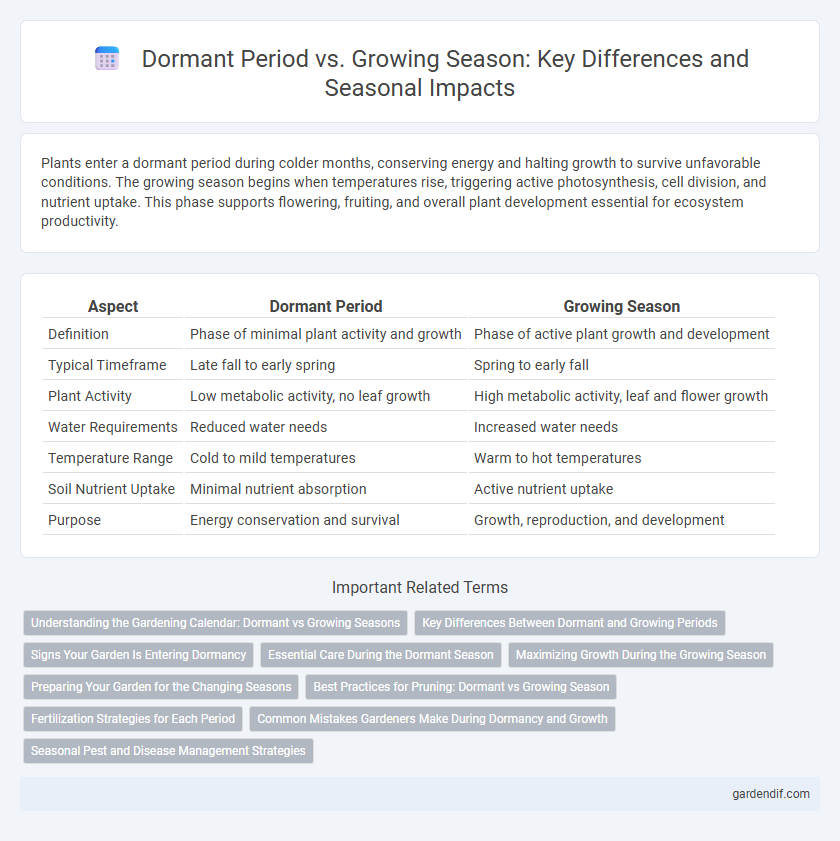
Dormant period vs Growing season Illustration
Plants enter a dormant period during colder months, conserving energy and halting growth to survive unfavorable conditions. The growing season begins when temperatures rise, triggering active photosynthesis, cell division, and nutrient uptake. This phase supports flowering, fruiting, and overall plant development essential for ecosystem productivity.
Table of Comparison
| Aspect | Dormant Period | Growing Season |
|---|---|---|
| Definition | Phase of minimal plant activity and growth | Phase of active plant growth and development |
| Typical Timeframe | Late fall to early spring | Spring to early fall |
| Plant Activity | Low metabolic activity, no leaf growth | High metabolic activity, leaf and flower growth |
| Water Requirements | Reduced water needs | Increased water needs |
| Temperature Range | Cold to mild temperatures | Warm to hot temperatures |
| Soil Nutrient Uptake | Minimal nutrient absorption | Active nutrient uptake |
| Purpose | Energy conservation and survival | Growth, reproduction, and development |
Understanding the Gardening Calendar: Dormant vs Growing Seasons
Understanding the gardening calendar involves distinguishing between the dormant period and the growing season, which dictate plant activity and care requirements. The dormant period, typically occurring in winter, is characterized by minimal growth and reduced metabolic processes in plants, allowing them to conserve energy. In contrast, the growing season spans spring to early fall, marked by active growth, flowering, and fruiting, necessitating increased watering, fertilization, and pruning.
Key Differences Between Dormant and Growing Periods
The dormant period is characterized by minimal metabolic activity and halted growth, allowing plants to conserve energy during unfavorable conditions, often in winter. In contrast, the growing season features active photosynthesis, cell division, and development, supporting biomass accumulation and reproduction in favorable environmental conditions. Key differences include temperature dependence, resource allocation, and physiological processes that drive growth versus energy conservation.
Signs Your Garden Is Entering Dormancy
Falling leaves, wilting foliage, and slowed plant growth indicate your garden is entering dormancy, signaling a shift from the active growing season. Temperature drops and shorter daylight hours also trigger this period of rest, helping plants conserve energy for the next growth cycle. Recognizing these signs allows gardeners to adjust maintenance routines and protect vulnerable species during the dormant phase.
Essential Care During the Dormant Season
During the dormant period, essential care focuses on pruning, mulching, and protecting plants from extreme cold to ensure healthy growth in the upcoming growing season. Maintaining soil health by adding organic matter and avoiding overwatering prevents root rot and fungal diseases. Timely removal of debris and monitoring for pests enhance plant resilience and prepare them for vigorous growth once active growth resumes.
Maximizing Growth During the Growing Season
Maximizing growth during the growing season involves optimizing sunlight exposure, soil moisture, and nutrient availability to support active plant development. During the dormant period, plants conserve energy and undergo physiological changes that prepare them for efficient growth once conditions improve. Employing techniques such as timely fertilization, irrigation, and pruning enhances plant vigor and productivity throughout the active growing phase.
Preparing Your Garden for the Changing Seasons
Preparing your garden for the changing seasons requires understanding the dormant period and growing season. During the dormant period, typically in late fall and winter, plants conserve energy and require minimal care, allowing soil to rest and enrich naturally. Transitioning into the growing season in spring and summer, gardeners must focus on soil preparation, planting, and regular watering to support vigorous plant growth and maximize yield.
Best Practices for Pruning: Dormant vs Growing Season
Pruning during the dormant period enhances plant health by minimizing stress and reducing the risk of disease while promoting vigorous growth in the upcoming season. In contrast, pruning in the growing season allows for immediate corrections and shaping, but it may hamper flowering and increase vulnerability to pests. Best practices recommend dormant season pruning for most deciduous trees and shrubs to maximize structural strength and growth potential, while selective pruning in the growing season suits evergreens and flowering plants needing deadheading or minor shape adjustments.
Fertilization Strategies for Each Period
During the dormant period, fertilization strategies focus on applying slow-release nutrients and organic matter to improve soil structure and replenish nutrient reserves without promoting excessive growth. In the growing season, targeted applications of nitrogen, phosphorus, and potassium are essential to support active plant development and optimize yield. Adjusting fertilization timing and nutrient ratios according to crop demands and environmental conditions enhances nutrient uptake efficiency and minimizes leaching.
Common Mistakes Gardeners Make During Dormancy and Growth
Many gardeners mistakenly overwater plants during the dormant period, disrupting root rest and increasing disease risk. During the growing season, common errors include under-fertilizing and failing to monitor pest activity, which can hinder plant development and yield. Understanding precise watering schedules and nutrient needs specific to each season optimizes plant health and growth cycles.
Seasonal Pest and Disease Management Strategies
Pest and disease management strategies differ significantly between the dormant period and the growing season due to variations in pest activity and plant vulnerability. During the dormant period, targeted applications of dormant oils and pruning practices help reduce overwintering pest populations and disease inoculum. In contrast, the growing season requires timely monitoring and integrated pest management (IPM) approaches, including biological controls, chemical treatments, and cultural practices to manage outbreaks and protect crop health.
Dormant period vs Growing season Infographic

 gardendif.com
gardendif.com